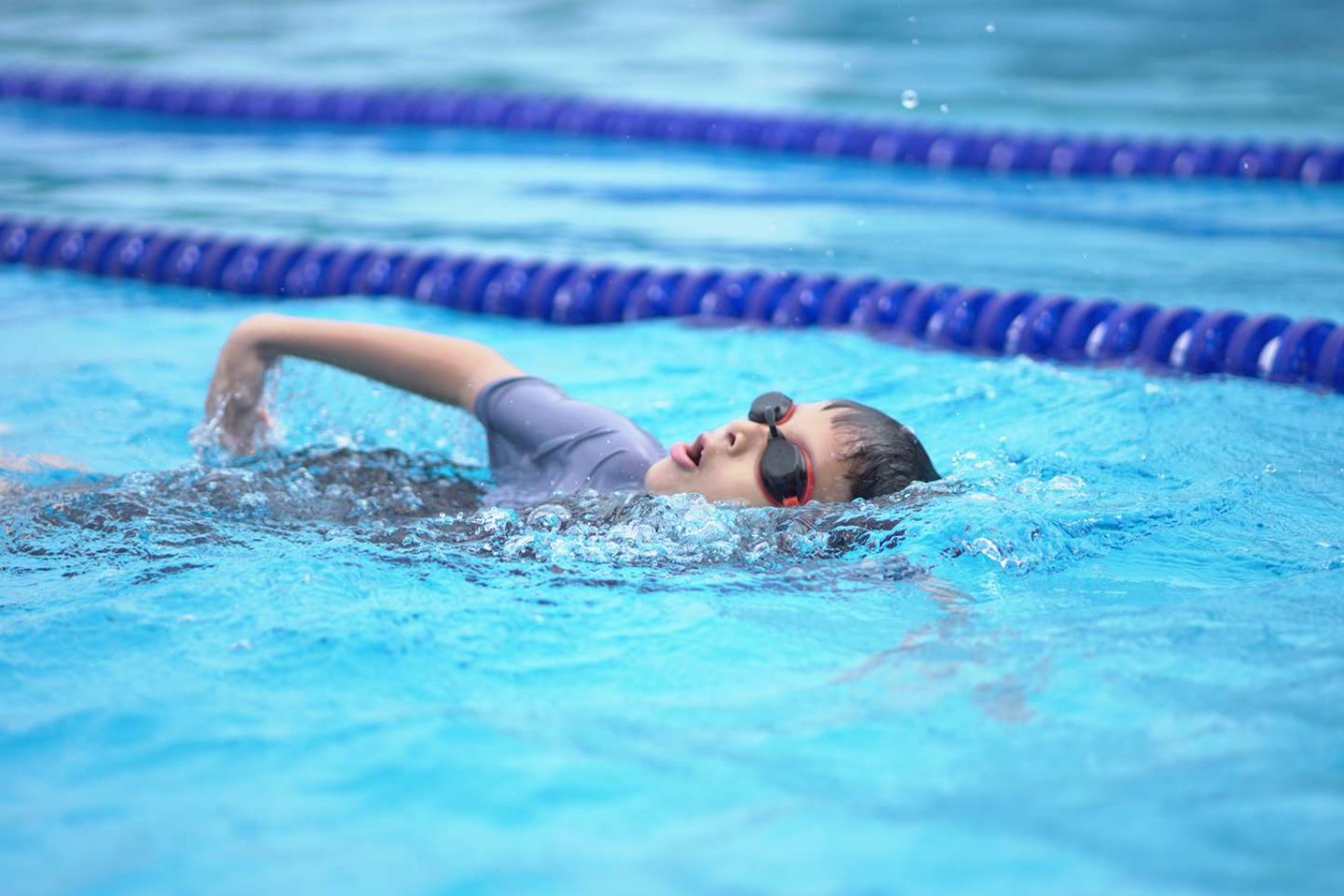A Guide to Perfecting Your Freestyle Swimming Breathing Technique

Freestyle swimming is one of the most popular and efficient swimming strokes, but mastering the freestyle swimming breathing technique can make a huge difference in your performance and comfort in the water.
Proper breathing not only helps you stay relaxed but also keeps your stroke smooth and efficient. In this guide, we’ll break down the key components of good freestyle breathing, explain how improper breathing can affect your swim, and share effective drills to help you breathe right every time you hit the pool.
Key Components of Freestyle Swimming Breathing Technique
Breathing while swimming freestyle might seem simple, but doing it the right way is super important to keep your stroke smooth and efficient. Here are several main things to focus on for a great freestyle swimming technique, especially when it comes to breathing:
1. Keep Your Breath Low, Straight, and Fast
Breathing will always slightly change your stroke, but the goal is to keep this change as small as possible. A low and quick breath helps you keep your rhythm, reduce drag, and keep moving forward smoothly.
2. Keep Your Head Low When You Breathe
Avoid lifting your head too high. Lifting causes your hips to drop and makes your arms work harder, which slows you down. Only lift your head just enough to get a good breath.
3. Rotate Your Head, Don’t Pull It To The Side
Instead of pulling your head sideways, rotate it along with your body. Pulling your head can mess up your body alignment. Rotating keeps your head in line with your spine, helping you swim straighter and more efficiently.
4. Breathe Quickly and Stay in Rhythm
Even with good technique, breathing interrupts your stroke a bit. So, take your breath quickly without breaking your swimming rhythm to keep your body position steady.
Impact of Improper Breathing Technique
Breathing correctly in freestyle swimming affects your entire stroke and performance. When your breathing technique is off, it can cause several problems that make swimming harder and slower. Let’s break down what happens when breathing isn’t done right:
A. Leads to Tiredness and Slower Swimming
When you don’t breathe enough or hold your breath too long underwater, your body doesn’t get the oxygen it needs. That means your muscles tire out quicker, and you lose energy before you even finish a few laps.
B. Disrupts Your Body Alignment
One of the most common mistakes swimmers make is lifting their head too far out of the water to breathe. When you do this, your hips and legs automatically drop, which creates more drag (water resistance).
C. Causes Extra Side-To-Side Movement
Improper breathing can cause extra movement in your shoulders and hips. If you twist your head too much or yank it to breathe, the rest of your body will start swaying, like you're zigzagging across the pool instead of going straight.
D. Your Arms Start Doing Weird Things to Compensate
When your breathing is off, your arms often go out of sync. Maybe your lead arm drops too early, or your recovery arm swings out wide to help balance the twist in your body.
E. You End Up Working Harder for Less Speed
All these little breathing mistakes add up. You feel more tired, your strokes are weaker, your body position is off, and you're dragging through the water instead of slicing through it. The result? You’re working really hard, but not going very far.
Breathing Pattern You Can Try
When watching swimming races, you’ll notice swimmers use different breathing patterns. The best pattern depends on the swimmer’s skill and how long the race lasts. Here’s a simple guide based on race time:
1. Races About 30 Seconds or Less
Breathe as little as possible to keep a fast stroke and reduce disruption. But don’t hold your breath longer than you’re comfortable.
2. Races Between 30 and 75 Seconds
Breathing every 2nd, 3rd, or 4th stroke works well. Many swimmers breathe every other stroke here and still go fast.
3. Races Longer Than 75 Seconds
Breathe every 2nd or 3rd stroke to get enough air and keep your energy up for the longer swim.
Timing in the Stroke Cycle
Exhale underwater, inhale quickly when your mouth is out. After inhaling, slowly exhale underwater until you do a strong final exhale just before your next breath.
This creates a vacuum that helps air rush in faster, making your breathing quicker and smoother. Fast and controlled breathing keeps your stroke steady and prevents getting overwhelmed by the need for air, which can mess up your technique.
Freestyle Breathing Drills to Try
Breathing properly in freestyle takes practice, and the best way to improve is by doing specific drills that help you get comfortable with your breathing rhythm and technique. Here are some simple drills you can try to boost your breathing skills and swim more smoothly:
1. Bobs
Practice rhythmic breathing by pushing off the pool bottom, letting your head break the surface to quickly inhale, then going back down and exhaling underwater. This helps you get used to breathing in rhythm.
2. Blowout Bobs
Like regular bobs, but you forcefully blow out all your air underwater before pushing back up. It’s harder but trains you to manage breathing under pressure.
3. Stroke and Roll
Swim freestyle and every time you breathe, roll completely onto your back, take a few breaths, then roll back and swim. This drill teaches proper rotation and timing when breathing.
4. Paddle Cap Freestyle
Place a paddle on your head and swim trying not to let it fall off. This helps you keep your head still and practice small, quick breaths.
5. Snorkel Swimming
Swim with a snorkel to focus on smooth stroke and head position without worrying about breathing timing. Switch between snorkel and normal breathing to improve your technique.
6. Cheat Breathing
Pretend you can’t fully breathe by turning your head slightly to the side to “cheat” a tiny breath. This helps you learn how small and subtle your breathing can be without disturbing your stroke.
7. Bilateral Breathing
Practice breathing to both sides instead of just one. This balances your stroke and improves your breathing by giving you new perspectives.
8. Restricted Breathing
Breathe less often than usual (for example, every 3rd or 6th stroke). This builds your ability to breathe well even when you really need air.
9. Blowout Freestyle
Before swimming, blow out all your air, then swim fast until you need to breathe. It helps you practice strong, quick breaths under pressure.
10. Quick-Breath Freestyle
This drill teaches you to separate your head movement from your arm recovery, helping you breathe faster and return your head to the water quickly.
Ready To Swim Faster and Feel Stronger?
Perfecting your freestyle swimming breathing technique takes time and practice, but it’s worth it! With the right breathing technique, you’ll swim more efficiently and feel more comfortable in the water. Keep practicing, and you’ll notice the difference in no time!
At Rockstar Academy, our swimming program is designed to help swimmers of all levels improve their skills, build confidence, and prepare for exciting competitions like the RockOlympics.
As part of our Sports & Performing Arts Academy, we combine expert coaching with a fun, supportive environment to make every practice enjoyable and effective.
If you are an advanced swimmer aiming to perfect your freestyle technique, our program also offers Private Instructions to help you reach your goals. Ready to dive in? Try our swimming program for free trial class and experience the Rockstar firsthand!
FAQ
How to breathe when swimming freestyle?
Breathe by turning your head to the side, keeping it low and aligned with your body, and inhale quickly when your mouth breaks the water surface. Exhale steadily underwater.
What is the best breathing technique for swimming?
The best technique is a quick, low, and side breath paired with proper head rotation to keep your body streamlined and minimize drag.



